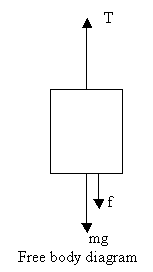In daily life, it is interesting, not only to know the work that can be done, but also the speed or rate the work is done.
The work a person can do is limited not only by the total energy output, but also by the speed that the person is able to transform that energy into an specific work output.
Power can be defined either as the rate at which work is done, or, as the speed of energy transfer per unit time.
Power = W/t = Work/time = transformed energy/time.
In the International System, power is expressed
as
Joules per second, unit that receives the name
Watt (W), 1 W = 1J/s.
When we say a small bulb wastes 60 watts, we are saying it transforms 60 Joules of electric energy every second into luminous energy and thermal energy.
For large power measurements we use the Horse Power, abbreviated as Hp, equivalent to 746 Watts.
1 Hp = 746 watts
Sometimes it is convenient to express power in terms of the net force F applied to an object and its velocity.
P = W/t, and as W = Fd and v = d/t where d represents displacement, we get,
P = Fv, this is, force times velocity.
Example 1.
Calculate the power a 1200 kg automobile requires for the following situations:
a) The automobile moves up a long hill inclined 8º with a constant velocity of 12 m/s.
b) The automobile accelerates from 14 m/s to 18 m/s in 10 s to pass another vehicle, on an horizontal road. Suppose a constant friction force for both situations equal to Fr = 500 N.

F denotes the force generated by the engine.
SOLUTION.
a) At constant velocity the acceleration is zero, so we can write:
F = Fr+mgsen

F = 500 N+1200 kg·9,8 m/s2 ·sen8º = 2.137 N
Using P = Fv, results P = 2.137N·12m/s = 25644 Watts, and when expressed in Hp, it is 34,3 Hp.
b) the acceleration is (18m/s-14m/s)/10s = 0,4 m/s2.
By the Second Newton's Law, the sum of all the external forces must be equal to ma, mass times acceleration.
F - Fr = ma
F = 1200kg·0,4m/s2 + 500N = 980 N
The necessary power to reach 18 m/s and pass the other vehicle is
P = Fv = 980N·18m/s = 17.640 Watts or 23,6 Hp.
Example 2.
An elevator whose mass is 1,195 kg can carry passengers with up to 935 kg mass. A 4,255 N constant friction force is opposite to the upward movement, as it is shown in the free body diagram below. a) What is the minimum power required by the engine elevator to make sure to lift the elevator at a constant speed of 4.5 m/s? b) What is the required power when the elevator is designed to develop an upward acceleration of 1.75 m/s2 and the speed is 4.5 m/s?.

Solution:
a) The free body diagram indicates the engine must develop a force T to rise the elevator. f represents the constant friction force and mg, the elevator weight.
Constant speed means zero acceleration, a = 0.
Second Newton' Law states:
![]() Fy = T - f - mg = ma = 0
Fy = T - f - mg = ma = 0
Where m is the total mass equal to 2,130
kg (elevator plus passengers). Then
![]() T = f + mg
T = f + mg
![]() T = 4.255x103
N + (2.13x103kg)(9.8m/s2)
T = 4.255x103
N + (2.13x103kg)(9.8m/s2) ![]() T
= 2.51x104N
T
= 2.51x104N
The power P is:
![]() P = Tv = (2.51x104
N)(4.5 m/s) = 11.3x104 W
P = Tv = (2.51x104
N)(4.5 m/s) = 11.3x104 W
b) Now the engine must do additional work
for accelerating the elevator. The only change in the setting of the problem
is that a ![]() 0
0
![]()
![]() Fy
= T - f - mg = ma
Fy
= T - f - mg = ma
![]() T = m(a + g) + f
T = m(a + g) + f
![]() = (2.13x103kg)(1.75
+ 9.8)m/s2 + 4,255 N =
= (2.13x103kg)(1.75
+ 9.8)m/s2 + 4,255 N = ![]() =
2.89x104 N
=
2.89x104 N
The necessary power P is:
![]() P = (2.89x104 N)(4.5 m/s) = 13.0x104 Watts
P = (2.89x104 N)(4.5 m/s) = 13.0x104 Watts
Most Related Sites
· Energy, Work and Power: Concepts
· Power
· Kinetic Energy
· Potential Energy
Related Sites:
· Physics, Main Page
· Physics, Mathematics
· Physics, Detailed Homework Scope Help
· Physics Problems, Example
· Physics Homework - Mechanical Energy Conservation Problems
· Physics Homework - Mechanical Power Problems
· Coulomb's Law
· Exercises Using Coulomb's Law
· Electric Field Charges
· Electric Field Exercises
· Electric Potential Energy
· Exercises, Electric Potential Energy
· Ohm's Law, Principle
· Ohm's Law Exercises
· Gauss' Law
· Gauss' Law Exercises
· Second Newton's Law
· Second Newton's Law Examples, Part One
· Second Newton's Law Examples, Part Two
· Sound Waves
· Sound Waves: Standing, Interference, Doppler Effect - Examples
· Sound Waves, Doppler Effect - Examples
· Vectors, Scalars
· Vectors, Scalars - Analytic Method
· Addition Vector Tools, Problems
· Free Fall Theory
· Free Fall Exercises, Part One
· Free Fall Exercises, Part Two
· Free Fall Exercises, Part Three